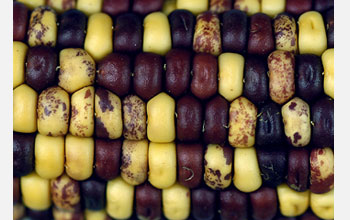Multimedia Gallery
Mobile pieces of DNA affect kernel colors of this 1949 ear from the McClintock collection.
Maize has long served as a model organism for studying genetics because many of its important genetic traits are expressed in kernels, and so are easily observed. While studying maize genetics more than 60 years ago, Barbara McClintock discovered mobile pieces of DNA, called transposable elements. Transposable elements affect the color of maize kernels and are responsible for the purple-colored sectors and spots shown in this 1949 ear of maize from the McClintock collection.
Credit: Robert Martienssen, Cold Spring Harbor Laboratory.
Images credited to the National Science Foundation, a federal agency, are in the public domain. The images were created by employees of the United States Government as part of their official duties or prepared by contractors as "works for hire" for NSF. You may freely use NSF-credited images and, at your discretion, credit NSF with a "Courtesy: National Science Foundation" notation.
Additional information about general usage can be found in Conditions.
Also Available:
Download the high-resolution JPG version of the image. (2 MB)
Use your mouse to right-click (Mac users may need to Ctrl-click) the link above and choose the option that will save the file or target to your computer.
Related story: Kernels of Truth: Researchers Sequence the Maize (Corn) Genome



